Private George Fleming Scarlett

George Fleming Scarlett was born on 21 February 1891 at Kiltoom, near Castlepollard, County Westmeath, the first of eleven children of shoemaker John Scarlett and his wife Kate (nee Small). By 1911 he was working as a groom and domestic servant at Cairncastle Lodge, County Antrim, for William Chaine, a wealthy landowner and the owner of Larne harbour.
Scarlett enlisted in the North Irish Horse between 8 and 10 August 1914 (No.967), one of the first to join after the declaration of war. He embarked for France on 18 December 1914, one of a draft of twenty reinforcements for A and C Squadrons – the first such group sent to France. Scarlett was probably posted to C Squadron.
In June 1916, C Squadron joined with F Squadron and the 6th (Inniskilling) Dragoons Service Squadron to form the 2nd North Irish Horse Regiment, serving as corps cavalry to X Corps until September 1917, when the regiment was disbanded and most of its men were transferred to the 9th (Service) Battalion, Royal Irish Fusiliers – renamed the 9th (North Irish Horse) Battalion. Like most of the men, Scarlett was transferred on 20 September. He was issued a new regimental number – 41497. He may have seen action with the battalion at the Battle of Cambrai in November and December 1917.
It seems that he was back in Ireland at the beginning of 1918 – perhaps he had been wounded, injured or fallen ill. On 6 February that year he deserted. Later, however, he re-enlisted, this time in the South Irish Horse, in the name of George Fleming. He was issued Corps of Hussars number 74182. His true identity was discovered, but what punishment was given is not known at present.
Scarlett later transferred to the Royal Army Service Corps (No. M/20820). He was discharged at the expiration of his term of engagement on 31 August 1922.
On 29 July 1919 Scarlett married carter's daughter Ellen Scarlett at St Patrick's Church of Ireland Parish Church, Ballymacarret. They lived for the rest of their lives at 3 Albert Drive in the Cregagh ex-servicemen's colony. In the 1960 Belfast Street Directory George is recorded as being a civil servant - he was probably a civil service messenger (a common occupation for ex-servicemen). He died in hospital in Belfast on 28 November 1960 and is buried in the Roselawn Cemetery.
Image sourced from Ancestry.com Public Member Trees - contributor George Hudson. Some of the information about his life after the war provided by Nigel Henderson at History Hub Ulster.
